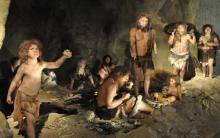9 891
The territory of Russia keeps many secrets. But Siberia is especially rich in mysteries - a place where peoples mixed, where huge ancient civilizations arose and disappeared.
Where did the Sargat disappear?
Siberian archaeologists are looking for an answer to the question: where did the ancient Sargats, whose kingdom stretched from the Urals to the Barabinsk steppes and from Tyumen to the steppes of Kazakhstan, disappear? There is an assumption that Sargatia was part of ancient Sarmatia and existed for more than 1000 years, and then disappeared, leaving behind only mounds. Scientists believe that on the territory of the Omsk region there is a special region of Sargatia - “Graves of Ancestors”.
At the beginning of the 20th century, a whole complex was opened, called
Novoblonsky. Sargat burial mounds were up to 100 meters in diameter and reached a height of 8 meters. Clothes made of Chinese silk with gold decorations were found in the graves of the nobility; the Sargat wore gold hryvnias around their necks.
DNA studies have revealed their similarity with the Hungarians and Ugrians. Nobody knows where the Sargat disappeared. Unfortunately, many graves were plundered by “miners” back in the 18th century. The famous Siberian collection of Peter I was composed of Sargat gold.
Is Denisovan man the ancestor of Australian Aborigines?

In 2010, during excavations in the Denisovskaya Cave in Altai, archaeologists found the phalanx of a finger of a seven-year-old girl who lived 40,000 years ago. Half of the bone was sent to the Institute of Anthropology in Leipzig. In addition to bones, tools and jewelry were found in the cave. The results of the genome study shocked scientists. It turned out that the bone belonged to an unknown species of human, which was called Homo altaiensis - “Altai man”.
DNA analyzes showed that the Altai genome deviates from the genome of modern humans by 11.7%, while for Neanderthals the deviation is 12.2%. No Altai inclusions were found in the genomes of modern Eurasians, but “Altai” genes were found in the genomes of Melanesians living on the Pacific Islands; 4 to 6% of the genome is present in the Australian Aboriginal genome.
Salbyk pyramid
The Salbyk burial mound is located in the famous Valley of the Kings in Khakassia and dates back to the 14th century BC. The base of the mound is a square with a side of 70 meters. In the 1950s, an expedition of scientists found an entire complex inside the mound, reminiscent of Stonehenge.
Huge megaliths weighing from 50 to 70 tons were brought to the valley from the banks of the Yenisei. Then the ancient people covered them with clay and built a pyramid, not inferior to the Egyptian ones. The remains of three warriors were found inside. Archaeologists attribute the mound to the Tagar culture and still cannot answer how the stones were delivered to the valley.
Mammoth Kurya and Yanskaya site
The ancient human sites discovered in Arctic Russia raise many questions. This is the Mammoth Kurya site in Komi, which is 40,000 years old. Here archaeologists found bones of animals killed by ancient hunters: deer, wolves and mammoths, scrapers and other tools. No human remains were found.
Sites 26,000-29,000 years old were found 300 kilometers from Kurya. The northernmost site was the Yana site, found on the terraces of the Yana River. Dated to 32.5 thousand years old.
The most important question that arises after the discovery of sites is who could live here if there was an era of glaciation at that time? Previously it was believed that people reached these lands 13,000 - 14,000 years ago.
The mystery of the Omsk “aliens”

10 years ago, in the Omsk region, on the banks of the Tara River in the Murly tract, archaeologists found 8 graves of the Huns who lived 1.5 thousand years ago. The skulls turned out to be elongated, reminiscent of humanoid aliens.
It is known that ancient people wore bandages to give the skull a certain shape. Scientists are wondering what prompted the Huns to change the shape of the skull so much? There is an assumption that the skulls belong to female shamans. Since the find raises many questions, the skulls are not displayed, but are stored in storage rooms. It remains to add that the same skulls were found in Peru and Mexico.
The mystery of Pyzyryk medicine

The burials of the Pyzyryk culture in the Altai Mountains were discovered in 1865 by archaeologist Vasily Radlov. The culture was named after the Pyzyryk tract in the Ulagan region, where the tombs of the nobility were found in 1929. One of the representatives of the culture is considered to be the “Princess of Ukok” - a Caucasian woman whose mummy was found on the Ukok plateau.
It recently became clear that the Pyzyryk people already had the skills to perform craniotomy 2300-2500 years ago. Now neurosurgeons are studying the skulls with traces of operations. Trepanations were carried out in full accordance with the recommendations of the “Hippocratic Corpus” - a medical treatise that was written at the same time in Ancient Greece.
In one case, a young woman apparently died during the operation; in another, a man with a head injury after trephination lived for several more years. Scientists say that the ancients used the safest technique for scraping the bone and used bronze knives.
Arkaim - the heart of Sintashta?
The ancient city of Arkaim has long become a cult place for mystics and nationalists. It is located in the Urals, discovered in 1987 and dates back to the turn of the 3rd – 2nd millennium BC. Belongs to the Sintash culture.
The city is distinguished by the preservation of buildings and burial grounds. It was named after the mountain, the name of which comes from the Turkic “arka”, which means “ridge”, “base”. The Arkaim fortress was built according to a radial pattern of logs and bricks, people of the Caucasian type lived here, there were houses, workshops and even storm sewers.
Also found here were items made of bone and stone, metal tools, and foundry molds. It is believed that up to 25,000 people could live in the city. Settlements of a similar type were found in the Chelyabinsk and Orenburg regions, in Bashkortostan, and therefore archaeologists called the area the “Country of Cities.”
The Sintash culture lasted only 150 years. It is unknown where these people went afterwards. Disputes about the origin of the city are still ongoing among scientists. Nationalists and mystics consider Arkaim a city of ancient Aryans and a “place of power.”
Orthodox science offers us too flat a theory of how human civilization developed. They say that scientific and technological progress has been progressive - from stone tools to modern genetic engineering and digital developments. But what if our distant ancestors explored space long before Gagarin’s flight? After all, this is indicated by indirect evidence. In this article we will describe some of the most impressive secrets and mysteries of ancient civilizations. Sometimes these artifacts are hidden underground or under a layer of volcanic ash. But it also happens that traces of ancient civilizations are before our eyes, but we still cannot figure out their purpose and meaning. A striking example is Stonehenge. What guided our ancestors when they erected huge blocks of stone, several tons each, in a certain order? Was there a race of giants on the planet? And how did humanity come about? You will learn unconventional answers from our article.
Classification of mysteries of ancient civilizations
It was as if ancient people deliberately did everything so that their distant descendants would have something to puzzle over. Then they lived where living conditions were almost impossible - for example, in Antarctica. Then they erected gigantic structures, the meaning and purpose of which still remain a mystery. How ancient people could deliver stone blocks is also shrouded in mystery. Only in recent years has the secret of producing Roman concrete been revealed, which is stronger than modern building material. Often our ancestors left encrypted messages. Some of them were solved, others were not. It also remains a mystery why some cities remained abandoned for no apparent reason. And the countries of Lemuria and Atlantis disappeared from the face of the earth, but remained in historical documents. Did they ever exist, or are they still waiting in the wings under a layer of earth or in the depths of the sea, like the legendary Troy? Scientists are also haunted by some of the results of archaeological excavations that do not fit into the modern scientific paradigm. for example, the skeletons of giant people.

Series of books “Mysteries of Ancient Civilizations”
People are constantly attracted to unsolved mysteries. What can you do, it’s human nature. Therefore, the mysteries of history and archeology are of interest not only to scientists of this narrow profession, but also to a wide range of people. These unsolved mysteries have long gone beyond the scientific world. To satisfy the interest of the public, a series of books were published that summarized all the mysteries of ancient civilizations. Some of these opuses are more related to science fiction or esotericism. But among them there are also invaluable works.

I would like to draw the attention of the Russian-speaking reader to the book “Riddles of Ancient Civilizations”, published in two volumes by the Eksmo publishing house. Also interesting is the series of the same name from “Veche”. The books of this publishing house, among other things, also touch on the secrets of Ancient Rus'.
Secrets of history and archeology in cinema
Of course, in our century, the mysteries of the sudden disappearance of civilizations, strange artifacts found and inexplicable buildings of antiquity are actively played out in films. Many exciting films have been made on this topic. And some of them, alas, have nothing to do with the real story. But there are also quite solid documentaries. We can recommend watching the series filmed in the USA with Brit Eaton. This documentary is called “Mysteries of Ancient Civilizations.” He is trying to answer questions about many mysterious events of the distant past.

The documentary Ancient Alients, presented by the History Channel, examines the possibility of paleocontact from different angles and comprehensively. After all, it is somehow necessary to explain the gigantic structures of the ancients, the furrows in the fields that look like intricate drawings or runways, figurines of people in spacesuits, rock paintings that depict aerodynamic devices in detail, and much more.
What is "forbidden archaeology"
Over the last hundred years, many artifacts have been raised to the surface of the earth that cause, at the very least, bewilderment. And some of them, such as the imprint of a human hand in limestone that is 110 million years old, or iron nails falling out of a lump of coal, refute the teaching of orthodox science about the date of the origin of the species Homo sapiens. Such finds are hushed up, at least until scientists are able to give them a clear explanation. Some artifacts relate to the mysteries of ancient civilizations. Forbidden archeology hides from the public strange metal spheres with an engraving in the form of three parallel grooves encircling the entire ball. These small artifacts, which were found by South African miners in the Precambrian strata, are 2.8 billion years old! Strange stone balls of different diameters - from giant spheres to the size of a tennis ball - were found in the 30s of the last century in Costa Rica. A piece of metal pipe, made, according to rough estimates, 65 million years ago, does not fit into the scientific picture of the world.

Was there paleocontact?
Numerous “gadgets”, such as a battery from Baghdad, made two thousand years ago, or a spark plug from the mountains of California, 500 centuries old, as well as objects from the Tibetan village of Bayan-Kara-Ula, reminiscent of vinyl records with an encrypted message, suggest that the culprits of some of the mysteries of history are aliens. And ancient civilizations would not amaze us today with large-scale buildings and highly technical artifacts, if not for paleocontact with aliens. Do we see the imprint of a human palm in the layers of the Cambrian period? The burials of giant people more than two meters tall baffle archaeological scientists. By the way, not far from the Tibetan village where stone disks with encrypted messages were found, a cemetery was also discovered. The tallest skeleton in it is only 130 centimeters tall. The disproportionately large heads of the dead of this necropolis suggest that they belong to some other race.

Disappeared megacities
Not only small objects and bones present mysteries of history and archaeology. Ancient civilizations left behind a much more monumental mark. For example, abandoned cities. And the age of some of them dates back to the period when, according to scientists, people were supposed to wear skins and get their food by hunting and gathering. A prime example is Cahokia. According to Europeans, Indians lived in North America at the tribal stage of development. But the pre-Columbian metropolis of Cahokia shatters this claim. The city had a population of forty thousand people. This is more than the European capitals of that time. There were temples in the city, and objects found in excavations suggest that the inhabitants actively traded with tribes and peoples across the continent. But around the thirteenth century the city was suddenly abandoned. What caused this? Nobody knows this.

Search cities
The chronicles have left us riddles about ancient civilizations. Historical documents mention countries such as Atlantis and Lemuria, the cities of Troy and Acre. But where are they? Guided by indirect data and their own intuition, scientists managed to find the legendary Troy, sung by Homer, as well as Machu Picchu, lost in the mountains of Peru. And recently Acre was discovered. For the past fifty years, the foundations of this fortified city have rested peacefully under... a Jerusalem parking lot. It is known that Antiochus Epiphanes, who ruled in the second century BC, ordered the construction of Acre. This Syrian king forcibly Hellenized the population. He ordered the Jerusalem temple to be turned into a sanctuary of Zeus, which caused a riot among the Jews.
The Mystery of Atlantis
What cities are there! Entire disappeared countries are today mysteries of ancient civilizations for historians. Despite the discovery of a detailed map of the island country compiled by contemporaries, and Plato’s description of the capital of Atlantis, they are still looking for it. The chronicles indicate that it was located behind the “Pillars of Hercules”. What does this phrase mean? Is this geographical feature the Strait of Gibraltar, separating the Mediterranean Sea from the Atlantic Ocean? Where to look for a mysterious country? Some scientists are inclined to believe that Atlantis was one of the islands of the Canary archipelago. Others believe that the island went under water as a result of a natural disaster (volcanic eruption and associated tsunami) in the Mediterranean Sea. But the fact is that Atlantis was a country with a high level of development of culture and science.

Encrypted letters
Modern science imposes the opinion that ancient people first encoded information in drawings, then stylized them in the form of hieroglyphs. The alphabet is supposedly the highest development of writing. But the artifacts found refute this claim. Some inscriptions still remain mysteries of ancient civilizations. They can be decoded only if they are duplicated in other languages understandable to scientists. A prime example is the Rosetta Stone.

On the basalt slab, the order of the Memphis priests was engraved in hieroglyphs, demotic and ancient Greek writing. Thanks to the last language known to linguists, the language of the Egyptians was deciphered. The secret of Jötunvöllur, the Scandinavian code, was recently revealed. It turns out that the Vikings knew writing, actively exchanged messages on tablets and made maps.
Hittites
The mysteries of ancient civilizations also include the question of how they arose. Orthodox science speaks of the progressive development of technology. But the Hittite civilization completely contradicts this. It seemed to come out of nowhere - along with the ternary counting system, writing, arithmetic, a complex lunisolar calendar, brewing and other signs of a developed culture. At a time when in other parts of the earth human tribes were still hunting with stone-tipped spears, the Hittites erected the city-states of Ur, Eridu, Ushma, Kisi, Uruk, Lagash.

Six thousand years BC, this mysterious people knew the wheel, bronze, and fired brick. Moreover, deeper cultural layers do not indicate the progressive development of this culture. The Hittites came from somewhere and disappeared somewhere - and this is another mystery of the history of ancient civilizations.
Megalithic structures
Apparently, ancient people liked to carry heavy blocks over long distances. There is numerous evidence of this, scattered throughout the world - from Japan to Western Europe. The clearest evidence of megalithic civilization is Stonehenge, which is located on Salisbury Plain in Great Britain. More recently, it became clear that the stone blocks located around in a certain order are not the only monument of that era. Stonehenge is a visible part of a whole complex of similar structures. What was it: a pagan temple or an ancient astronomical observatory?

Scientists have yet to figure this out. The origin of the stone idols of Easter Island remains unclear. What about dolmens in different parts of the world? What about megaliths in Siberia? How many mysteries did the ancients leave us? And which of them can be solved?
Artifacts of “forbidden” archeology
Today, the world has collected a huge amount of credible evidence that many of the technologies and principles used in 20th century technology were known to disappeared civilizations. And the number of these testimonies is growing every month. In the most ancient burials of the Aztecs, as well as in excavated Scythian burial mounds dating back thousands of years, the skulls of warriors were discovered with signs of skillfully performed trepanations and with the thinnest gold plates implanted into the holes on the head. Ancient people were wonderful dentists: in Scythia, in the lands of the Mayans and Aztecs, and especially in Ancient Egypt, the remains of people with gold crowns and bridges in their mouths were found at different times. In the burials of the nobility (about three thousand years old) in 1998 in Giza (Egypt) two skeletons with... artificial eyes and three with prosthetic legs and arms were discovered!
It is known that scientific and practical gynecology appeared in the second half of the 19th century. However, back in 1900, the American magazine Scientific American reported on sensational excavations in Pompeii. It turns out that the Temple of the Vestals preserved medical instruments, buried under the ash of Mount Vesuvius, which are “strikingly similar to those used in modern gynecology.” They are made of good metal and are as high quality as today's ones! The inhabitants of Hellas knew how to make excellent steam boilers, which, however, were not widely used at that time.
In 1900, sponge catcher Mikael Tsanis from the island of Antikythera lifted an ugly bronze object from a 12-meter depth, the purpose of which no one understood. And only almost 60 years later, Professor D. Sollara, who studied the wonders of the Antikythera Museum, recognized it as an exceptionally amazing mechanism! It was a unit with a complex set of plates, levers, and gears, representing... an exact model of the Solar System! Of course, it was used to calculate the orbits of planets. It is curious that Mars on the unit was painted red, the Earth – green, and the Moon – silver... “It becomes downright scary and extremely annoying when you think that on the eve of the death of their civilization, the ancient Greeks managed to get so close to the civilization of the 20th century .!” - Dr. Price wrote in 1960 in Scientific American magazine.
Mechanism found off the island of Antikythera
Four thousand years ago in Great Britain there lived a small community of people at the level of the Stone Age. Using primitive tools made of stone and bone, they could barely support their existence. However, these people in some incomprehensible way managed to create quarries in the Cambrian Mountains and extract huge stone blocks weighing up to 30 tons, which were then dragged over a distance of 240 miles to the area of modern Amesbury and placed in circles with the highest precision! This structure was called Stonehenge, which means “Hanging Stones.” (See separate story about Stonehenge.) Astronomers and other scientists have been studying Stonehenge for centuries. According to their conclusion, the installation of stone blocks was calculated taking into account the position of celestial bodies and the phases of the Moon. Thus, the entire structure probably represents a giant prehistoric calendar. Those who developed the Stonehenge project knew mathematics and astronomy well.
While excavating south of Baghdad, German archaeologist Dr. Wilhelm Koenig discovered electrochemical batteries that are more than two thousand years old! The central elements were copper cylinders with an iron rod, and the cylinders were soldered with a lead-tin alloy, which is still used today. Engineer Gray made an absolute copy of such a battery, and, amazingly, it worked for a long time, being presented to visitors to an exhibition of technical experiments in Munich!
It is appropriate to recall the notorious “Colombian golden plane” - a rarity accidentally discovered by experts among the exhibits of the Columbia Historical Museum. Its antiquity has been proven: analysis has shown that the thing dates back to the turn of the 1st and 2nd millennia. The eight-centimeter figurine from a museum in Bogota is an exact replica of a 1970s fighter jet! Moreover, its enlarged model, tested on an aviation stand, showed excellent aerodynamic qualities and covered more than 200 m in free flight! The manuscripts of the Ancient East contain a lot of information about flying machines in India one and a half thousand years before the birth of Christ! We are talking about vimanas - “rattling flying carriages with people inside.” The noise apparently came from a jet engine.
Ancient Chinese myths talk about the legendary civilization of Chi-Ki. Its representatives used “air crews.” The Chronicle of Scientists says that the great engineer of the Han Dynasty created a bamboo apparatus with a mechanism inside, with the help of which a pilot could fly about two kilometers. A manuscript by the alchemist Co Huynh, dated 320, describes an ancient propeller device: “Flying baskets were made, the interior of which was made of wood, and leather straps were attached to the rotating blades to set the mechanism in motion.”
According to historian William Dale, the ancient Egyptians rose above the clouds in hot-air balloons and primitive gliders, which was the exclusive privilege of members of the pharaoh family. “Many members of the royal family,” says Dale, “died with broken legs and multiple injuries that could have been sustained by falling with the aircraft.” Based on his research, the scientist suggests that Tutankhamun was also a victim of a plane crash! He came to this amazing discovery after 20 years of studying the history of Ancient Egypt. William Dale is convinced that the strange objects with wings depicted on numerous frescoes are nothing more than the first flying machines! The historian personally made a dozen such devices (models), and it turned out that “many of them feel great in the air.” According to the scientist, the Egyptians launched the first hot air balloon in 3225 BC, and the glider - 2000 years later. Balloons and gliders were made from papyrus and had wingspans of up to 18 m. They were launched from steep cliffs or pyramid-like structures and could cover distances of up to 80 km!
From the book Forbidden Archeology by Baigent MichaelAncient artifacts... On June 22, 1844, The Times published an unusual story. The article was called “An Unusual Incident.” A few days earlier, the article explained, near Rutherford on the River Tweed, workers in a quarry had found a gold thread in a piece of rock.
From the book 100 Great Mysteries of the Ancient World author From the book Forbidden Archeology by Cremo Michelle AArtifacts from Aix-en-Provence (France) In his book Mineralogy, Count Bournon writes about an intriguing discovery made by French workers in the late 18th century. Describing the details of the discovery, Bournon wrote: “In 1786, 1787 and 1788 they mined stones near Aix-en-Provence in France for
From the book Forbidden History by Kenyon DouglasChapter 40 ARTIFACTS IN SPACE For writer Richard Hoagland, the trail of ancient extraterrestrial civilizations grows warmer. Since 1981, a gigantic and mysterious face peering out from the Cydonia region on Mars remains a tantalizing hope for the possibility of scientific proof.
From the book Secrets of the Lost Civilization author Bogdanov Alexander VladimirovichArtifacts And now, so that it is absolutely clear to the reader that before the collapse of Monogea we - all or almost all earthlings - had common ideas about God and the world, I will present, with slight abbreviations, information from the research of the famous scientist and publicist on Jewish studies
From the book Treasures and Relics of Lost Civilizations author Voronin Alexander Alexandrovich From the book Easter Island author Nepomnyashchiy Nikolai Nikolaevich author Warwick-Smith Simon From the book The Cycle of Space Disasters. Cataclysms in the history of civilization author Warwick-Smith Simon6. Era Artifacts from the Chobot Site SUNRISE ON BLUE LAKE In search of another Clovis-era dig site in Canada, I headed north from Calgary to Edmonton, Alberta, and drove to the houses overlooking Buck Lake. Checking into a beach motel
From the book From the history of dentistry, or Who treated the teeth of Russian monarchs author Zimin Igor ViktorovichChapter 1 Dental Artifacts The concept of an artifact has long existed in archeology. As they write in academic dictionaries, an artifact (from the Latin Artefactum - artificially made) is a phenomenon, process, object, property of an object or process, the appearance of which in the observed
From the book “Mysteries of History” Magazine, 2012 No. 1 author Magazine "Mysteries of History"incredible artifacts MUMMY: THE PATH TO IMMORTALITY =============================== ======================================== The ancient Egyptians believed in an afterlife. They believed that the soul is like a bird with a human face, which can fly all day, but by night must return to
From the book Jesus and His World [Newest Discoveries] by Evans Craig by Fagan Brian M.Artifacts, Subassemblages, and Assemblages As we saw in Chapter 4, archaeological evidence represents the material remains of ancient human activity. This data can come in many forms, and a major part of archaeological research is
From the book Archaeology. At first by Fagan Brian M.Part V Analyzing the past. Artifacts and Technology People who look at the world through the eyes of an archaeologist will never be able to look at the world like ordinary people. They were hurt by what others call little things. The sense of time can be developed as long as the old shoe is in the grass or
From the book Archaeology. At first by Fagan Brian M.Artifacts. The importance of context In 1953, British archaeologist Kathleen Kenyon unearthed a burial site of human skulls covered in plaster in a hole under the floor of a house in Jericho in the Jordan Valley. Each head was a naturalistic individual portrait with
From the book Archaeology. At first by Fagan Brian M.Artifacts and artistic styles Ideology is a product of society and politics. It is a complex of doctrine, myth and symbolism associated with a social movement, institution, class or group of individuals, often with reference to some political or
Almost any archaeological find provides a vast topic for controversy. Moreover, scientific disputes in the scientific world take place even around the most famous historical artifacts. Our review contains 15 controversial issues in archeology, about which scientists still argue today.
1. Bust of Nefertiti

Since the discovery of the bust of Nefertiti in Egypt by German archaeologists in 1912, there has been ongoing debate for 100 years regarding its repatriation to Egypt, as well as its authenticity. Today the bust is kept in Berlin.
2. Temple of Tikal

Regarding this Mayan temple, the debate is not about its origin and purpose, but about the fact that archaeologists decided to partially dismantle the temple in order to get to the oldest masonry.
3. Grolier Code
This pre-Columbian Mayan manuscript first appeared in a private collection in the 20th century (from a New York collector). Since then, there has been debate among archaeologists regarding its authenticity.
4. Treasure hunt

One of the most controversial areas in archaeology. On the one hand, this science arose precisely thanks to treasure hunters, but treasure hunting today is condemned by all states, as well as by archaeologists themselves, who are concerned about the preservation of ancient monuments.
5. Map of Piri Reis

The map, drawn by the Ottoman admiral Piri Reis, is allegedly a copy of one of Christopher Columbus's maps. This map is one of the items of national pride in Turkey. There is debate regarding its supposed accuracy, especially in relation to the new world and the Antarctic coast.
6. Baghdad Battery

This is the name of a number of artifacts discovered in 1930 in Iraq. Archaeologists have suggested that they were used to store vinegar or wine. However, there was an assumption that the vessels could be used as galvanic cells, and current was generated in them. During experiments, it was proven that this is possible.
7. Fifth Skull

One of the five skulls discovered in Dmanisi, Georgia, is of unusual size. This led to an ongoing debate in the archaeological community over whether the skull belongs to an early form of Homo erectus.
8. Cyrus cylinder

An ancient cylinder covered with Akkadian cuneiform was discovered in 1879 in what is now Iraq. The Persian king Cyrus the Great ordered a list of his victories and merciful deeds to be engraved on this clay cylinder. Some scholars view these texts as evidence of the repatriation of Jews from the kingdom, while others see them as the most ancient charter of human rights.
9. Atlantis

Although the existence of an actual sunken city has not been confirmed, scholars still debate as to what inspired Plato's writings.
10. Stonehenge

Because Stonehenge was built by a culture that left no written records at all, there is much debate as to the real purpose of the site.
11. Monte Verde, Chile

Archaeological excavations at Chilean Monteverde in Chile have led most archaeologists to believe that humans settled in the Americas much earlier than previously thought.
12. Runamo

Runamo is a network of rock cracks in the Swedish province of Bleking. As is commonly believed, these cracks form a huge runic script. But some scientists argue that the cracks are simply the result of natural wear and tear on rocks.
13. Nazca Lines
History buffs will also be interested in learning about. After all, there is evidence of this, little known today, but at the same time great.Humanity has existed for many thousands of years, and it seems that scientists have managed to thoroughly study all stages of its development. However, this is a big misconception, since even now, in the age of high technology, science has no way to solve several of the most important historical mysteries. Archeology has unearthed miles and miles of ancient settlements, but some finds have been as shocking as they are unknowable. We can only guess what they mean, although the solution to these secrets could change our entire understanding of the historical process.
Sea Peoples
Scientists are still wondering who the so-called “Sea Peoples” were who raided cities across the Mediterranean 3,200 years ago. As evidenced by the ceramics of that time, these tribes lived in the Aegean Sea region, but then migrated to the Middle East. Now attempts are actively continuing to unravel the motives of the “Sea Peoples”, according to which they organized a bloodbath for their neighbors. Perhaps an artifact found this month in Turkey with a huge inscription in the language that these tribes most likely spoke will shed some light.

Geoglyphs
Not so long ago - during the First World War - British Air Force pilots discovered strange drawings on the ground in the Arabian Peninsula. They looked like giant bicycle wheels. Scientists began research and found out that they were created in 6500 BC. This is very strange, because geoglyphs are not visible from the ground, and you can only look at them from a bird's eye view.

Rooms in the Cheops pyramid
Research conducted by participants in a project to scan Egyptian pyramids has shown that the Cheops pyramid may have two previously unknown internal cavities. For a number of reasons, some dispute this sensational result and try to conduct alternative research. However, despite this, voids can exist, and, accordingly, something historically priceless can be hidden in them.

The Secret of the Valley of the Kings
The Valley of the Kings has been used since ancient times to bury the remains of the royal families of Egyptian rulers. Most of the tombs were destroyed at different times. However, according to some researchers, it is worth resuming the search because there must be undiscovered tombs in this place. Most likely, the wives of the pharaohs with all their wealth are buried in them.

Dead Sea Scrolls
The Dead Sea Scrolls consist of thousands of fragments of texts that were written 2,000 years ago and found in 12 nearby caves in modern-day Israel. Who wrote the Dead Sea Scrolls is perhaps the most heated scientific debate, the leading version of which remains the Essenes sect. These people wrote a lot and kept manuscripts in caves until the Roman army expelled them from their homes. But this theory is becoming less popular as evidence has been found that the scrolls were brought to the site from elsewhere.

Oldest Christian artifact
Currently, the earliest surviving Christian artifacts are papyri from the second century. They arose a hundred years after the supposed death of Christ. However, today scientists are coming to the conclusion that one of the Gospel copies may be almost the same age as Jesus. This is a fragment of the Gospel of Mark, dating from the first century of the new era.

Viking route
It is known that in the year 1000 the Vikings reached the shores of North America for the first time. However, there their traces are lost, and it is unknown where they continued to migrate. More recently, artifacts have been discovered indicating that the northern coast of North America may have been their long-term site.

Philistines
The Philistines arrived in the Levant (the area that today includes Israel, Palestine and Lebanon) about 3,200 years ago. But this is practically the only information that we reliably know about them. Scientists draw the rest of their information from Egyptian texts, but they were biased towards this people. Since then, the Philistines have acquired a reputation as warlike people who do not value culture or art. But new excavations in Gath and Ashkelon seem likely to forever change the understanding of this most mysterious ancient people, as well as why there is no truthful information left about them.











Biography of the Reich President of the Weimar Republic
Biography of Pavel Dybenko Dybenko Pavel Efimovich biography
Appointment of Cardinal Richelieu as First Minister
Love horoscope for the sign Libra for September
Horoscope for April Pisces the Witch